Mandalay is the second largest city in Myanmar with more than 1,2 million inhabitants. It was established in 1857 as the last capital of Burma kingdom. It lies on the east bank of the Ayeyarwaddy River, Myanmar’s most important commercial waterway that flows through the country from north to south. Mandalay is a thriving trade hub thanks to its central geographical location in the country. It looks quite different compared to Yangon and is more dusty and industrial; but there is much to see for a visitor anyway, including several ancient capitals of Burma located on the outskirts of Mandalay. 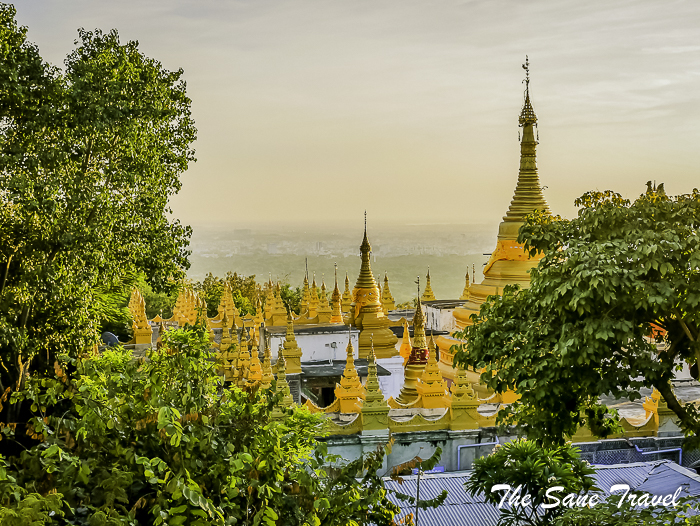
As distances between places to visit are quite long, you will need a tuk-tuk for the first full day trip and also to get to Mandalay Hill in the afternoon of the second day. So here are the sights I visited for your travel inspiration.
Day 1
Visit Royal Palace of Mandalay
The Royal Palace was built by King Mindon who moved his capital from Amarapura to Mandalay in the middle of the 19th century. The teak wood palace was built in the center of a large square citadel surrounded by walls 8 kilometres of total length and separated from the city by a 60 metre wide water-filled moat. In 1885 the British took Mandalay ending the monarchy of Burma. The Palace was converted into a fort for the British army. During the Second World War, the Royal Palace was burned down. The only two original buildings that survived are the Royal Mint and the watchtower.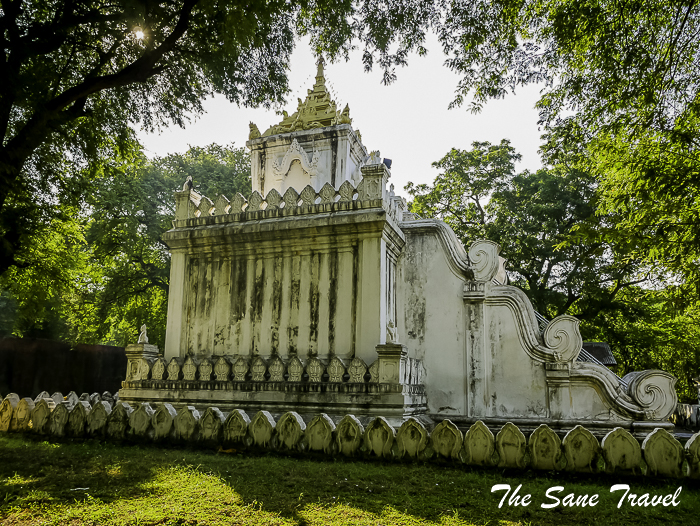
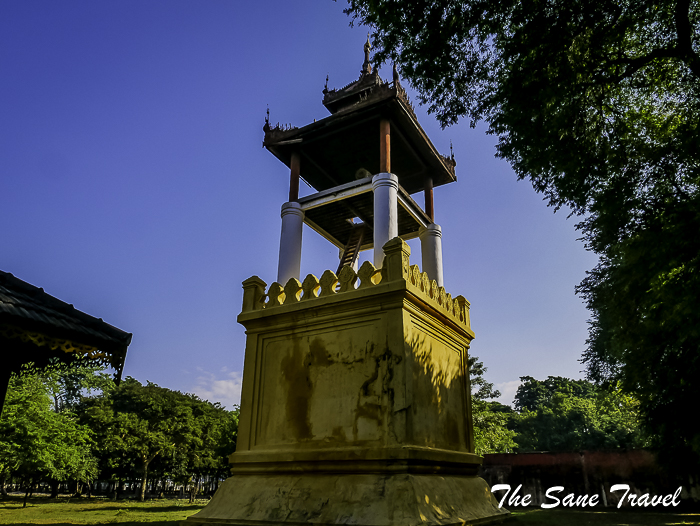 In the 1990’s the Palace was rebuilt and is now open for visitors. The entrance is the East gate of the citadel and you have to take some ten minutes to walk on the road surrounded by an operating Military Base to reach the Palace.
In the 1990’s the Palace was rebuilt and is now open for visitors. The entrance is the East gate of the citadel and you have to take some ten minutes to walk on the road surrounded by an operating Military Base to reach the Palace.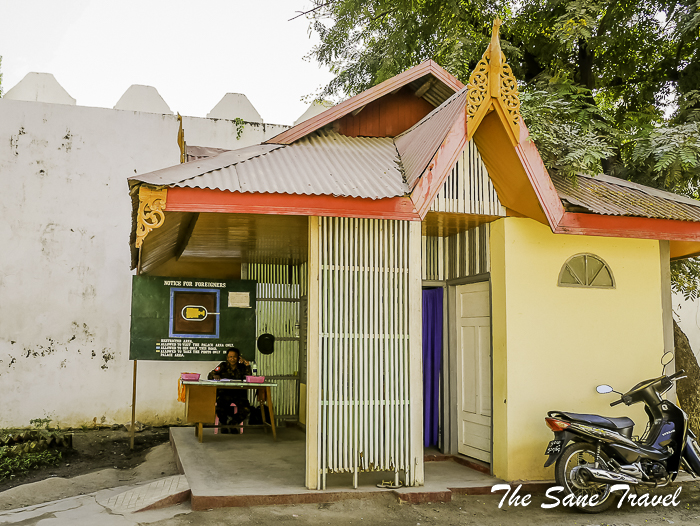

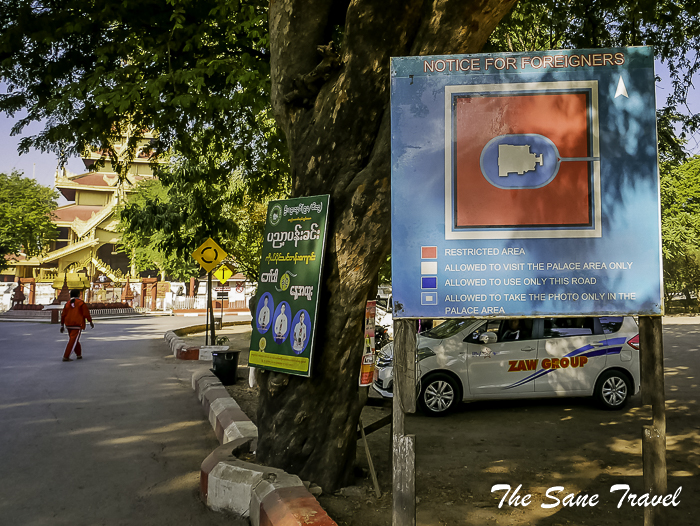 The large complex has many buildings to see, including throne halls and audience halls, among others.
The large complex has many buildings to see, including throne halls and audience halls, among others.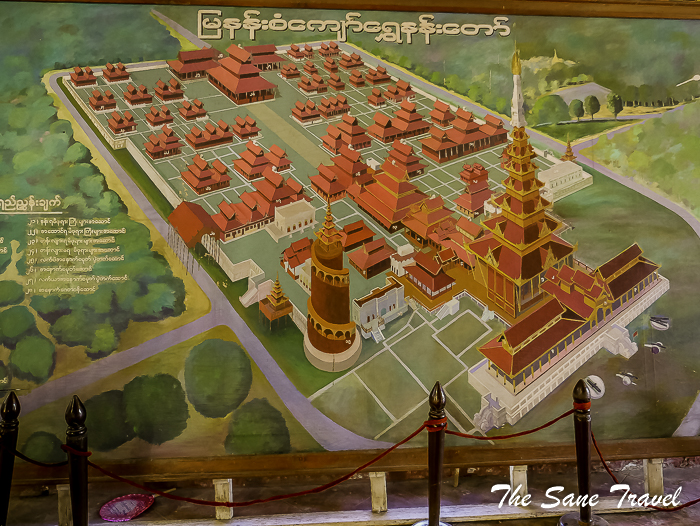
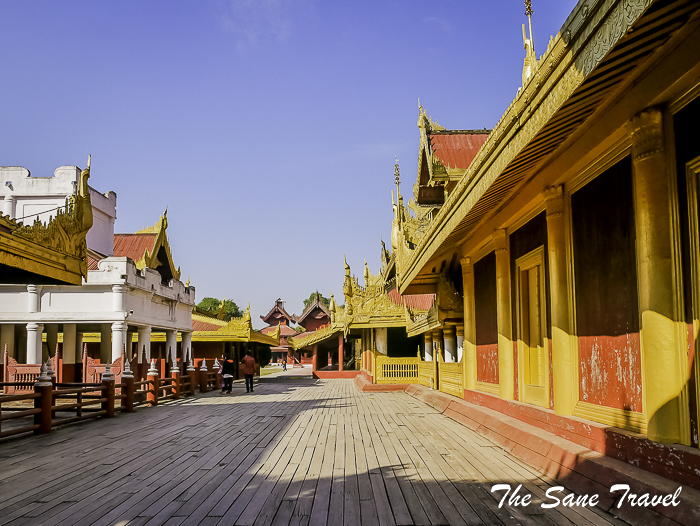
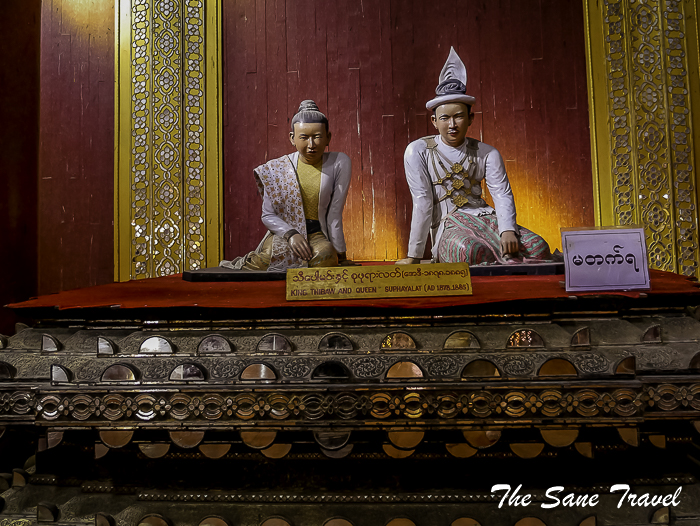 I found the museum quite interesting with several artefacts of the King’s life and life size statues of high officials of the Kingdom.
I found the museum quite interesting with several artefacts of the King’s life and life size statues of high officials of the Kingdom.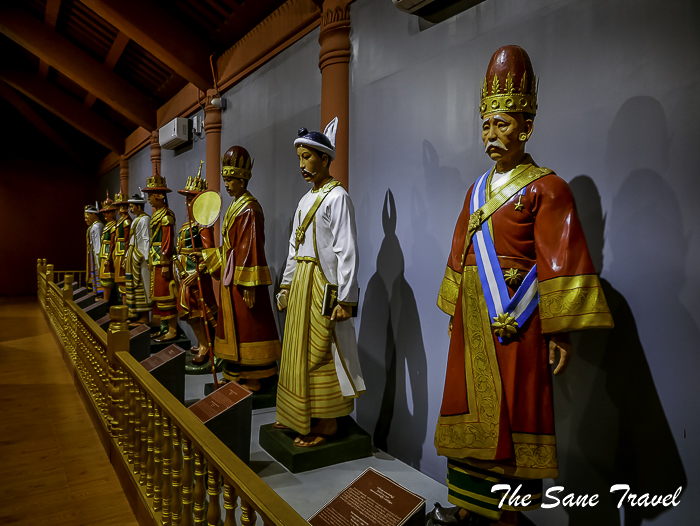

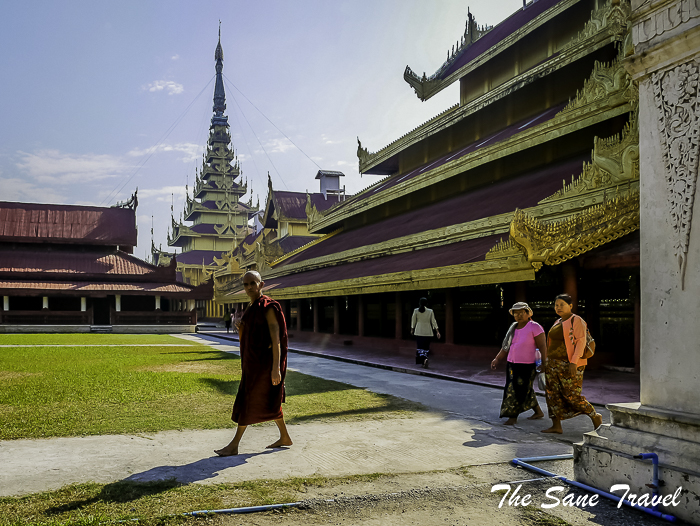
Practical information. At the entrance, you have to buy a ticket for 10 000 kyats, also valid for several other tourist attractions in and around Mandalay so keep it for other visits. We had to leave a passport with the security at the front gate and got it back when exiting. Opening Hours: 07:30-17:00
See the world’s largest book at Kuthodaw Pagoda
Built by King Mingdon in the second part of the 19th century, it contains 729 shrines with marble slabs with the complete text of the Tripitaka, Theravada Buddhism's most sacred text, known as “the world’s largest book”. At the center of the complex is a gilded 57 metre tall pagoda modelled on the Shwezigon Pagoda in Bagan. When the British army seized Mandalay in 1885, they vandalized the Kuthodaw complex, stole gold and valuables from the pagoda and removed the gold from the letters on the slabs. After the British had left, it took several decades until the works were completed and the Kuthodaw was restored to its former glory. The pagoda was covered by gold again, the letters on the marble slabs redone in black ink instead of gold.![21kuthodaw temple mandalay myanmar thesanetravel.com 1620649]()
![22kuthodaw temple mandalay myanmar thesanetravel.com 1620651]()
![27 kuthodaw temple mandalay myanmar thesanetravel.com 1620672]()
![24kuthodaw temple mandalay myanmar thesanetravel.com 1620657]()
![25 kuthodaw temple mandalay myanmar thesanetravel.com 1620660]()
![26kuthodaw temple mandalay myanmar thesanetravel.com 1620670]()
![28 kuthodaw temple mandalay myanmar thesanetravel.com 1620683]() Visit the ancient capital Inwa (Ava)
Visit the ancient capital Inwa (Ava)
Inwa (also known as Ava), the former royal capital of the Myanmar Kingdom from the 14th to 19th centuries, is located at the confluence of the Irrawaddy River and the Myitnge River, about 20 kilometres south of Mandalay. After a 3 minute boat ride crossing a small river, you will be met by many horse carts to make your ride there. If you expect to see a town or a city, you may be disappointed. It’s like the countryside with a few buildings here and there. While riding around, use the opportunity to watch the local life of the Burmese countryside in small villages on your way.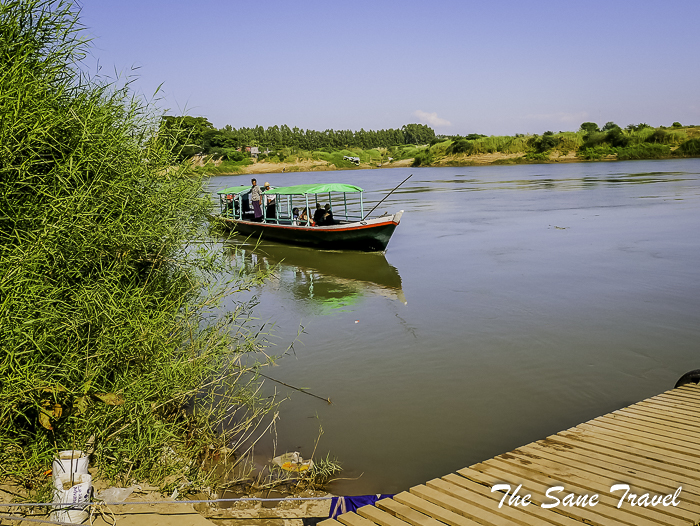
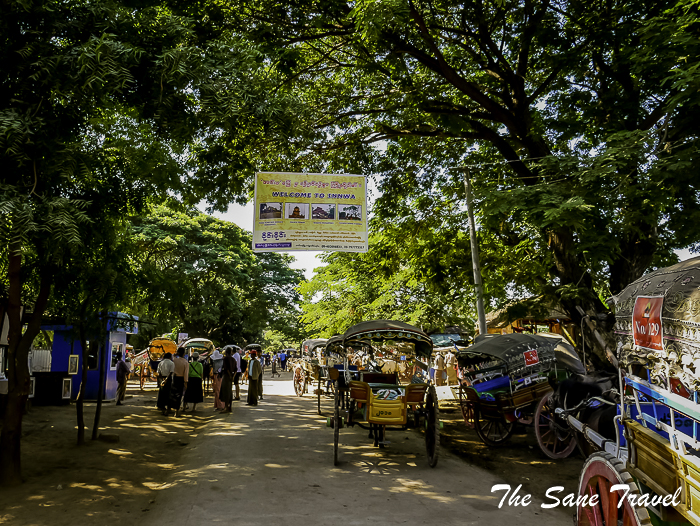 On the typical route, you’ll be taken first to the Yadana Hsemee (Sinme) Pagoda, and then you will visit the atmospheric teak-built Bagaya monastery and its surrounding stupas, the Nanmyint watchtower, and Maha Aung Mye Bonzan Monastery.
On the typical route, you’ll be taken first to the Yadana Hsemee (Sinme) Pagoda, and then you will visit the atmospheric teak-built Bagaya monastery and its surrounding stupas, the Nanmyint watchtower, and Maha Aung Mye Bonzan Monastery.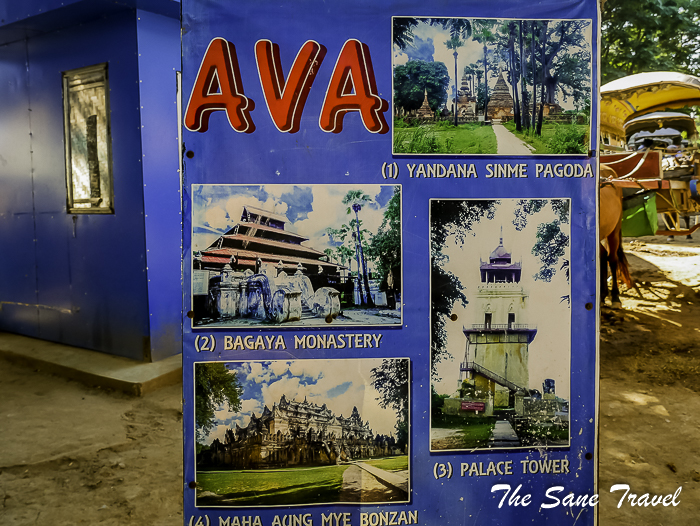


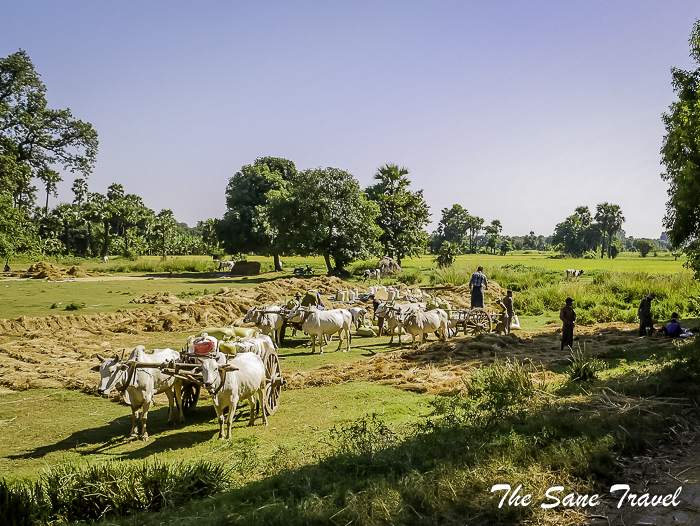
Yadana Hsemee Pagoda. Yadana means gem. Indeed it is a hidden gem hidden in the fields. It is about 500 years old and successive earthquakes have damaged the roof and left the Buddha image open to the skies.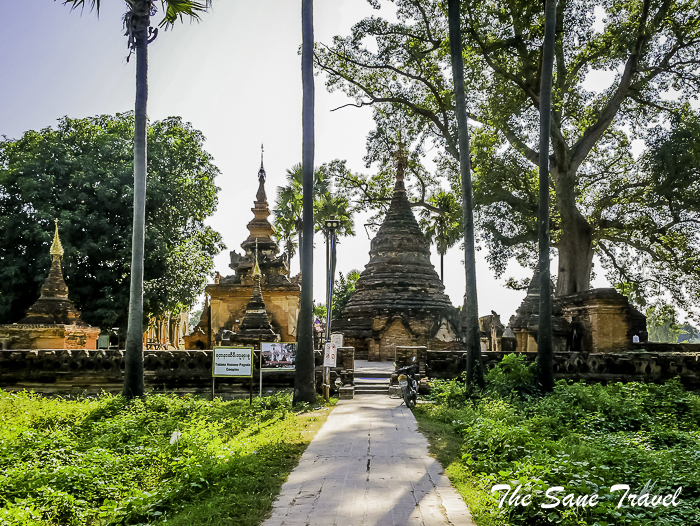
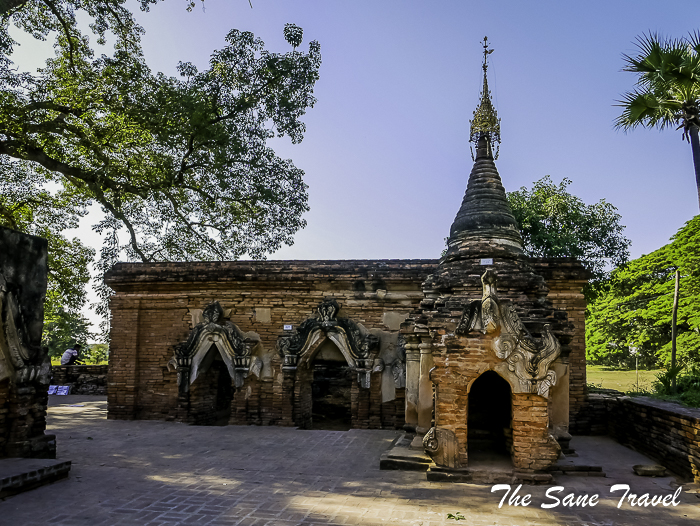
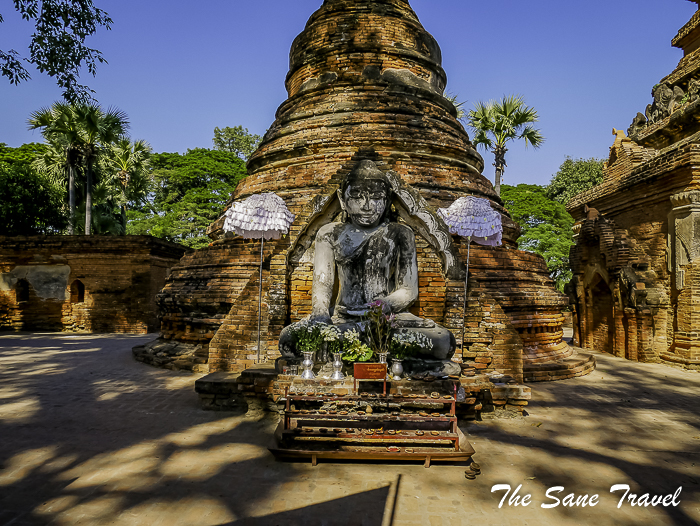
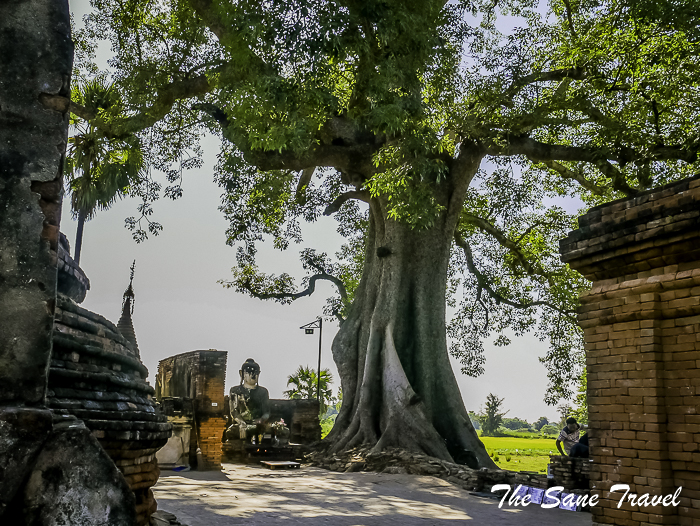
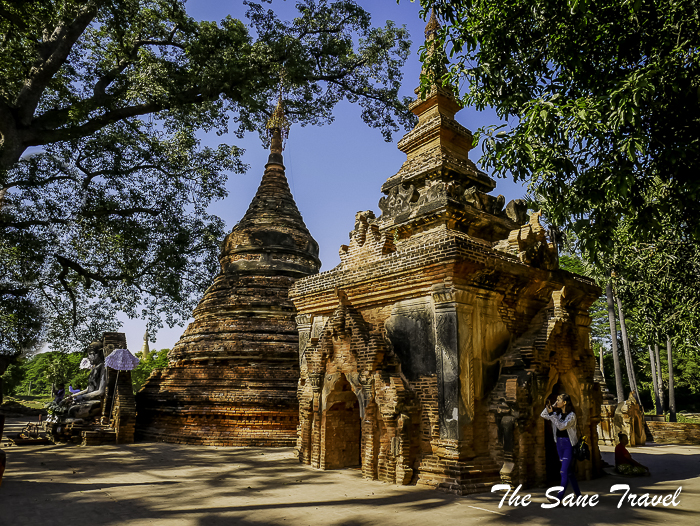
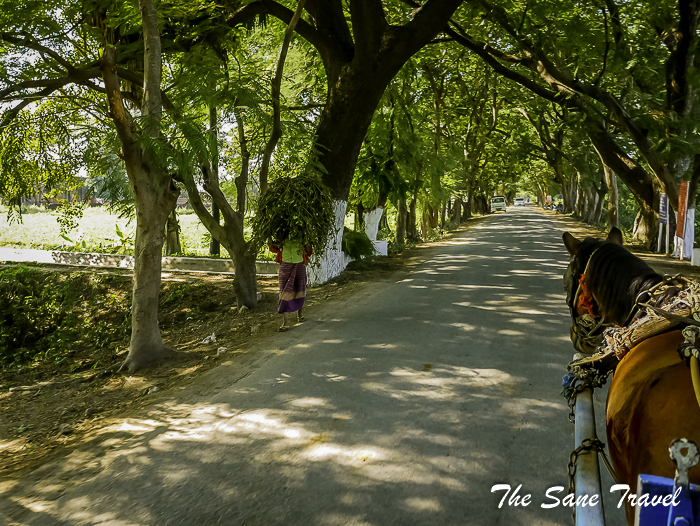
The Bagaya Monastery was built to the southwest of the Inwa palace at the end of the 16th century. The teak wood building of the monastery is decorated with floral carvings, and reliefs of birds and animals. The large teak door is beautifully trimmed with sculptures and reliefs.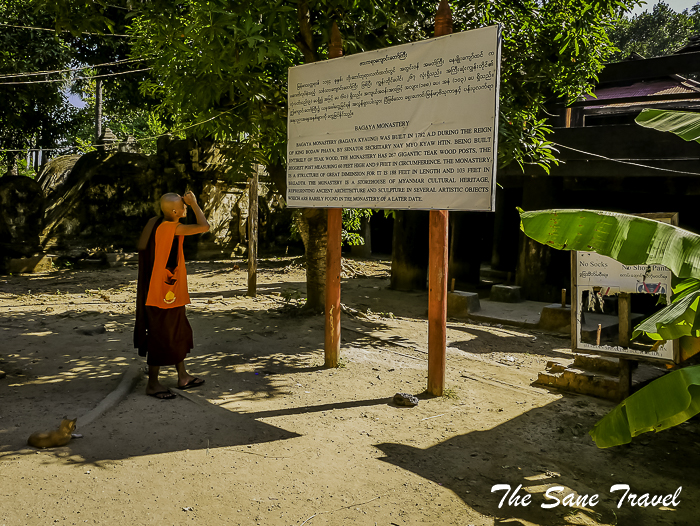
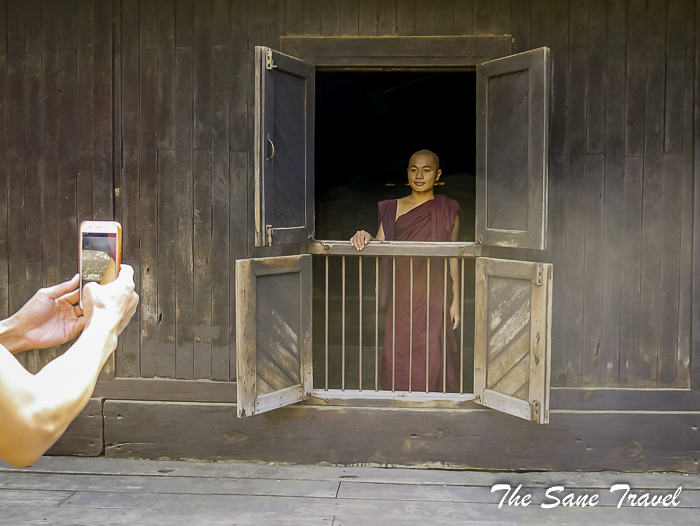
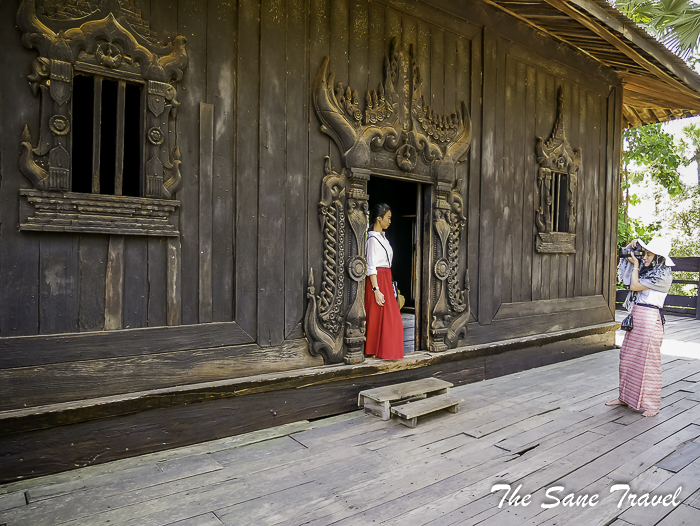
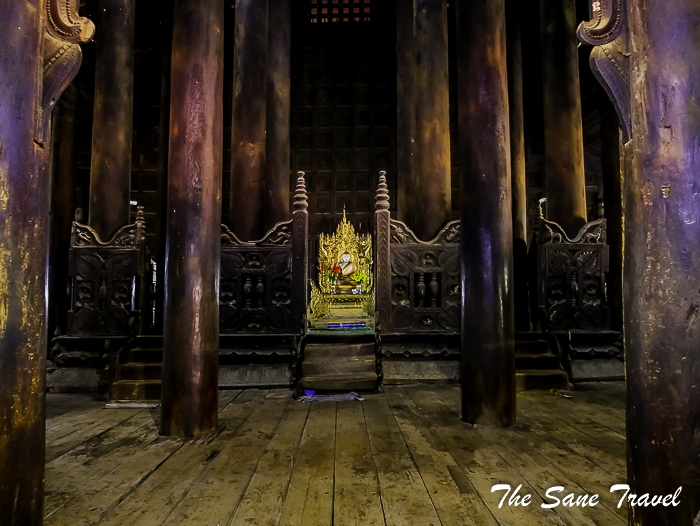
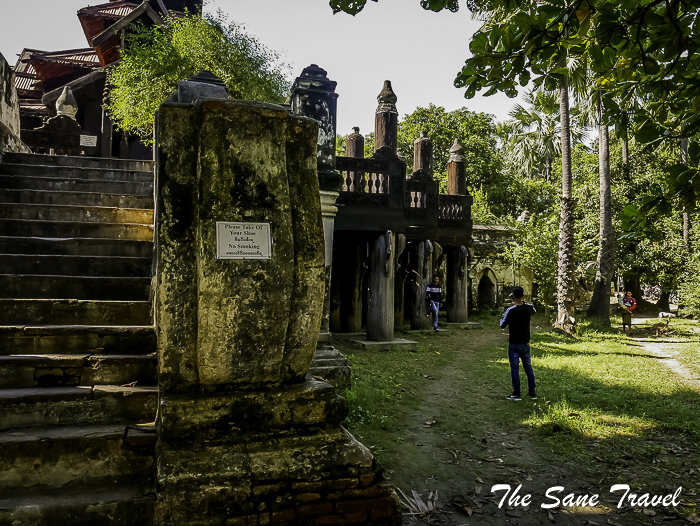
Watchtower. The 30 metres (about 90 feet) tall watchtower Nan Myint is a solitary building that remains of the Bagyidaw's palace of the early 19th century. Unfortunately, you cannot climb it because of the bad state of the stairs.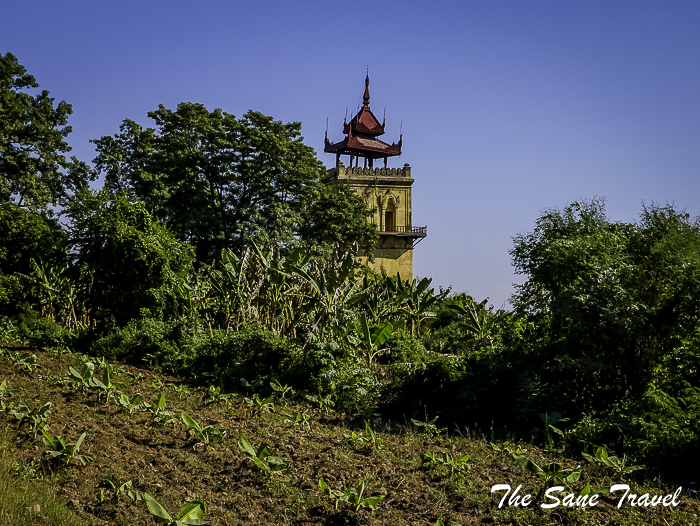
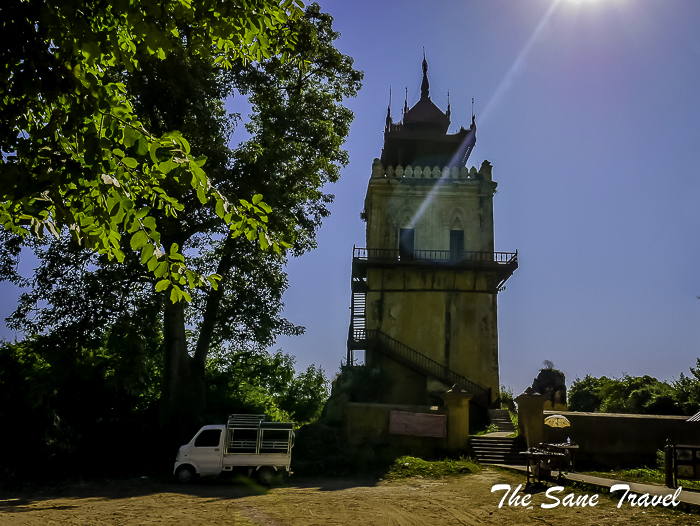 A real surprise to me was an ancient swimming pool in the middle of nowhere.
A real surprise to me was an ancient swimming pool in the middle of nowhere.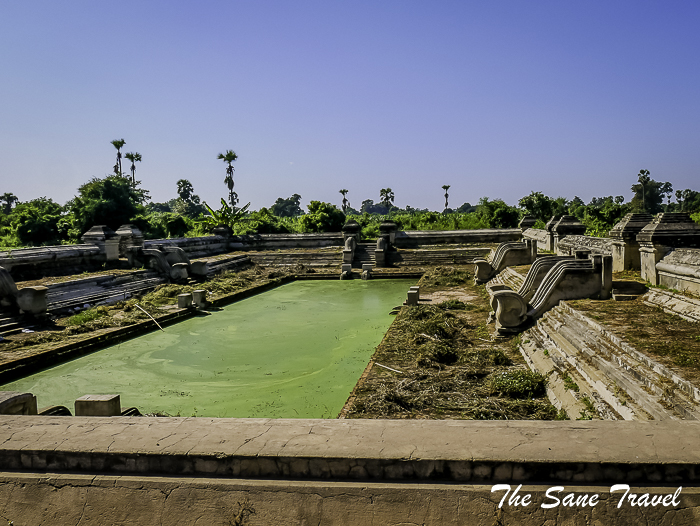 I was most impressed by the Maha Aung Mye Bonzan Monastery, also known as Brick Monastery, that was built in the early 19th century. This monastery is one of the finest examples of Myanmar architecture of the 19th century, getting inspiration from earlier wooden monasteries.
I was most impressed by the Maha Aung Mye Bonzan Monastery, also known as Brick Monastery, that was built in the early 19th century. This monastery is one of the finest examples of Myanmar architecture of the 19th century, getting inspiration from earlier wooden monasteries.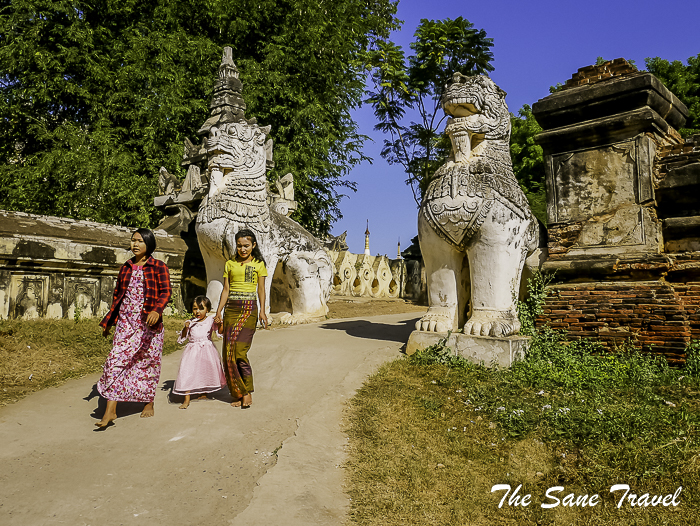
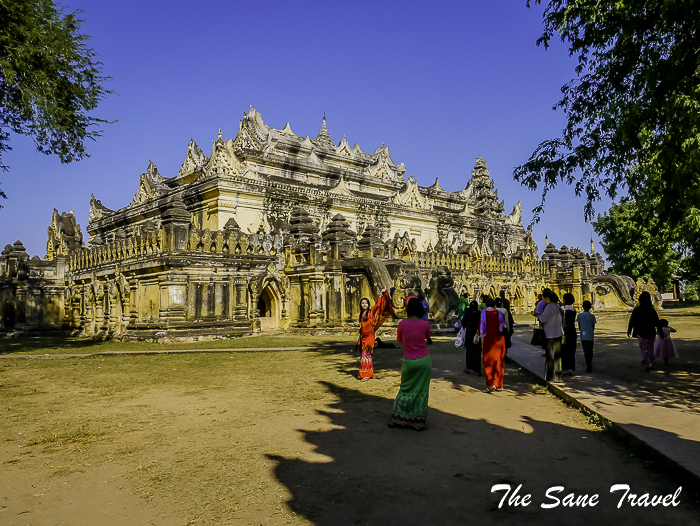
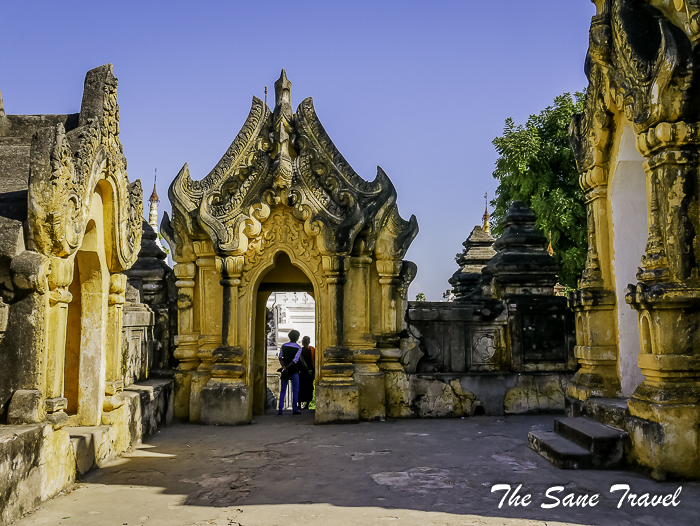
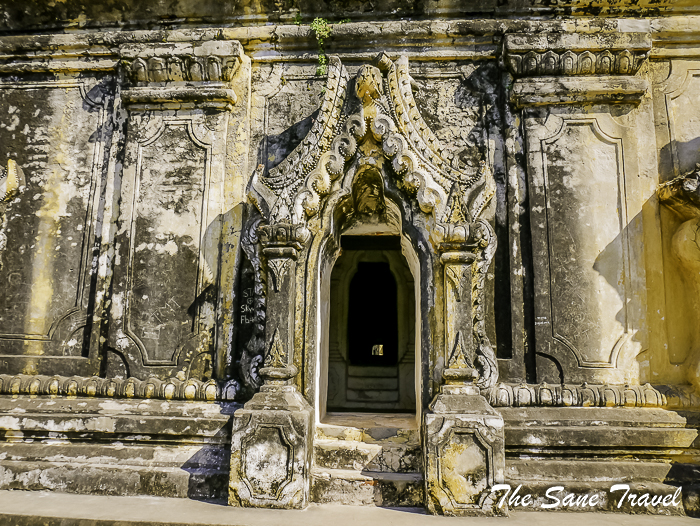
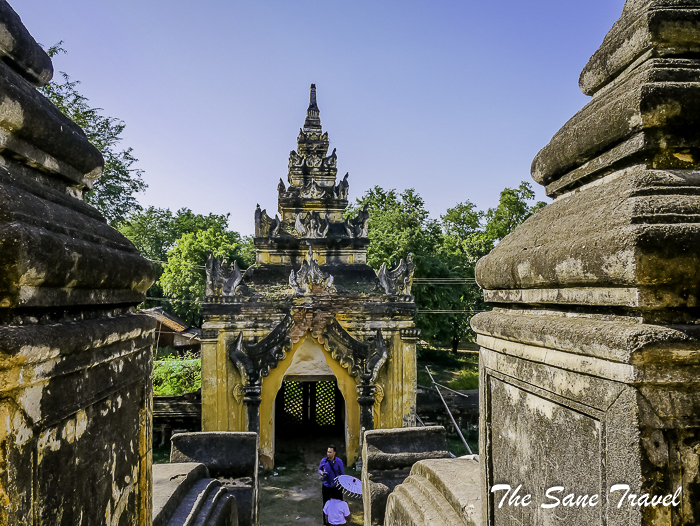
Practical information
You are expected to pay 1500 MMK per person for a boat ride that takes you across the river. It just takes a few minutes. As distances are not small in Inwa, you will need to use a horse cart for transportation, just agree on the price, usually around 10 000 kyats, and time in advance, otherwise you will be getting pressured to pay more if the ride time is more than 1,5 hours. From my experience, 1,5 hours is not enough. You will need at least two hours to visit all the places without an unnecessary rush. Use your Mandalay archeological zone ticket you bought at the Kings Palace in Mandalay to enter monasteries in Inwa.
Watch the sunset at U Bein bridge
On your way back from Inwa, stop at Amarapura to see the U Bein bridge. Situated 11 kilometres south of Mandalay, the unique U Bein Bridge is a beautiful 1.2 kilometre-long structure built from teak and said to be the longest of its type in the world. In the middle of the 19th century, when the capital was moved from the nearby Amarapura to Mandalay, the local mayor U Bein collected wood from a dismantled teak palace and used it to build this magnificent bridge. Enjoy a stroll along the bridge and take in the fabulous views of the surrounding farms and waterways.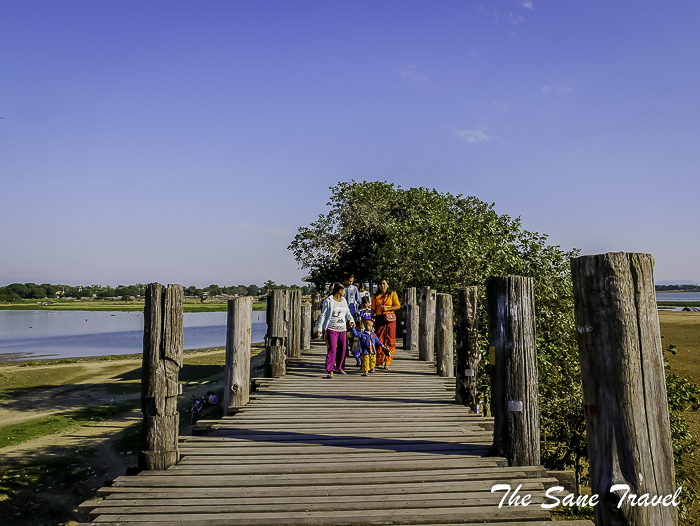
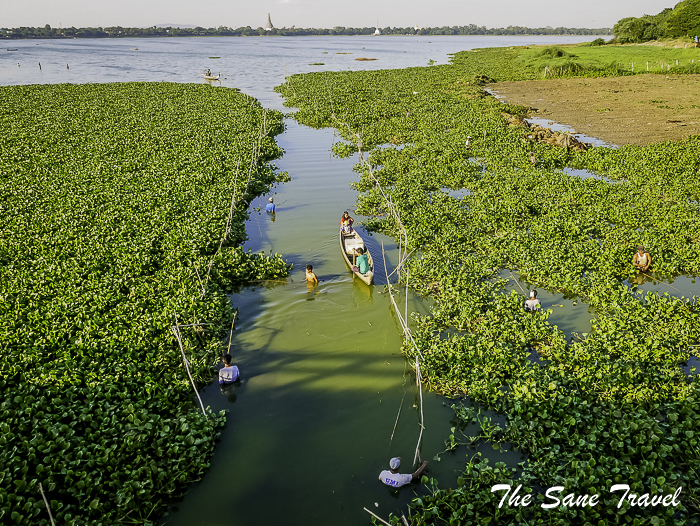
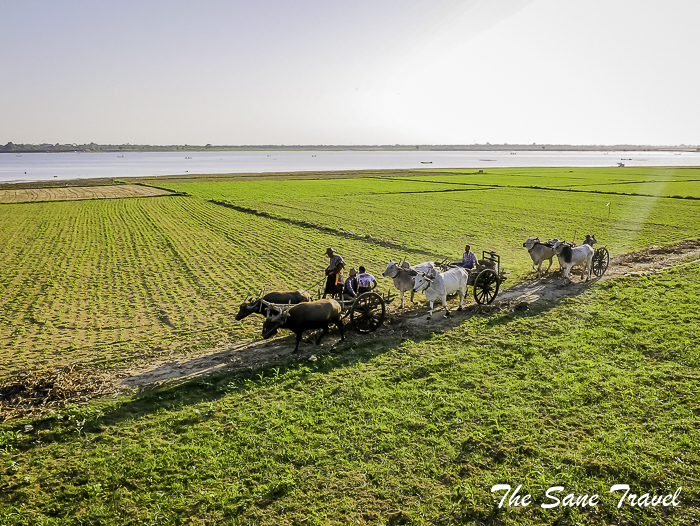
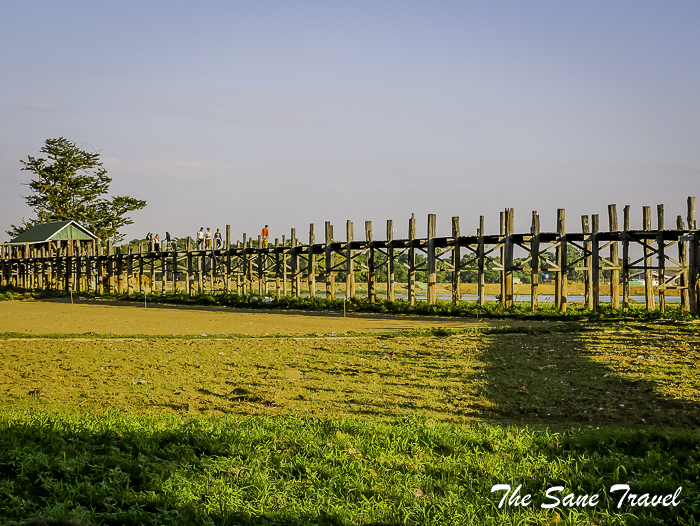 The views of the bridge are the most impressive at sunset. Have the best photo opportunities by hiring a boat to get a close up view of the bridge from the water.
The views of the bridge are the most impressive at sunset. Have the best photo opportunities by hiring a boat to get a close up view of the bridge from the water.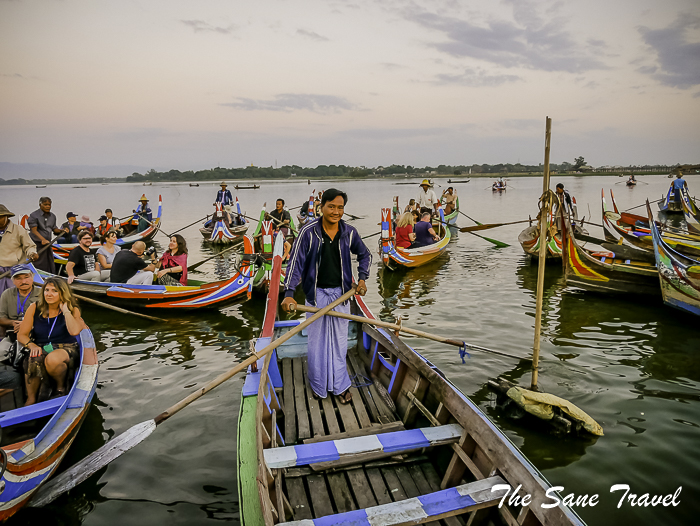
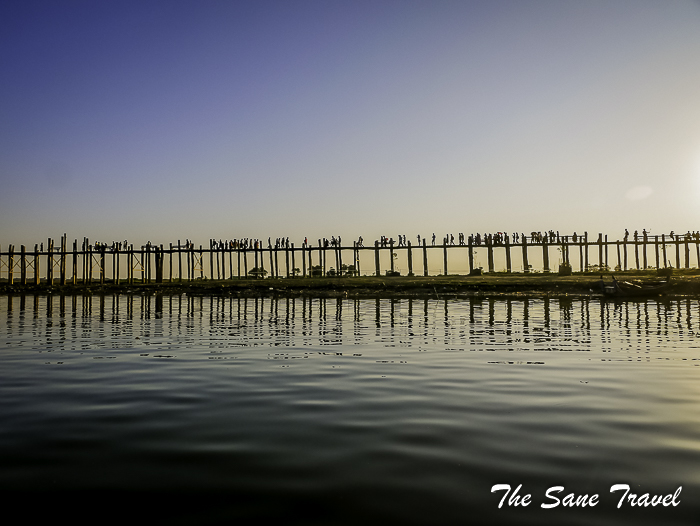
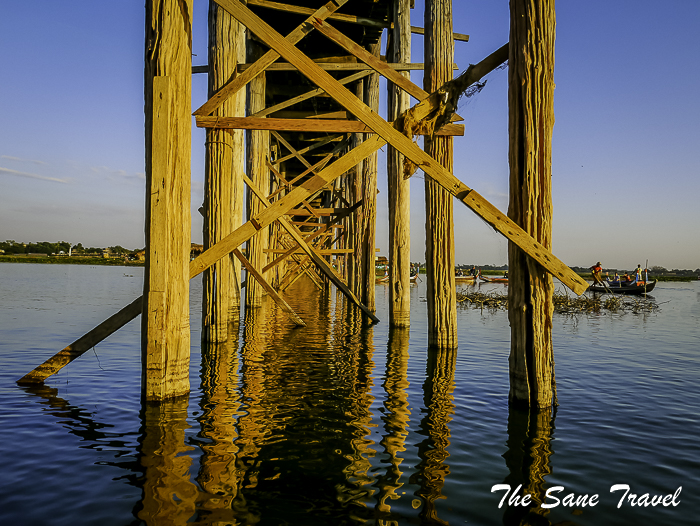
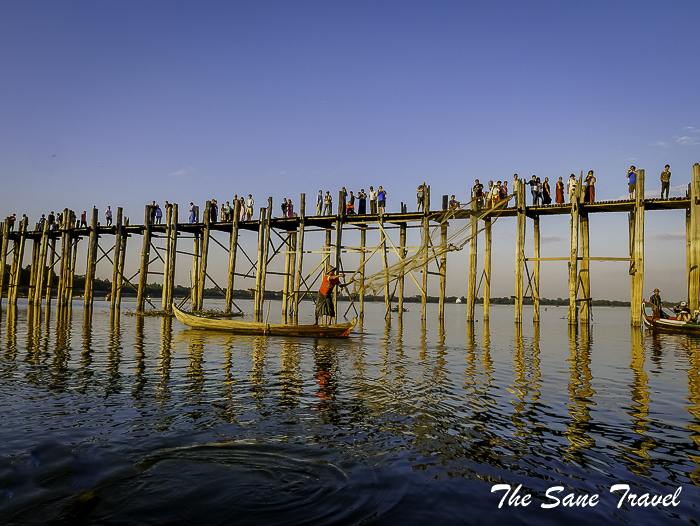

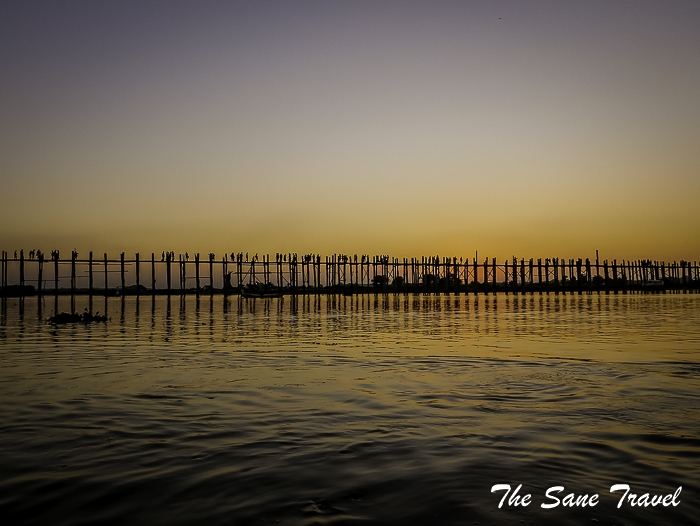
Day 2
Have it more relaxed and do not forget to try the street food of Mandalay. More options for food will arise in the evening. But in the morning
Visit King Galon Gold Leaf Workshop
Myanmar is known as a golden country and gold is found everywhere, from the quarries to the temples and Buddha statues. You will find a gold leaves in all the pilgrimage sites in Myanmar because people have a sacred tradition: rubbing gold leaves into a Buddha statue to show their devotion. Almost all of the gold leaf applied to Buddha images in Myanmar comes from a small area of Mandalay. There are about fifty gold leaf workshops, many of them around 36th Street, just east of the railway line. Mandalay King Galon Gold Leaf Workshop is the place where visitors can witness the entire process of making gold leaf.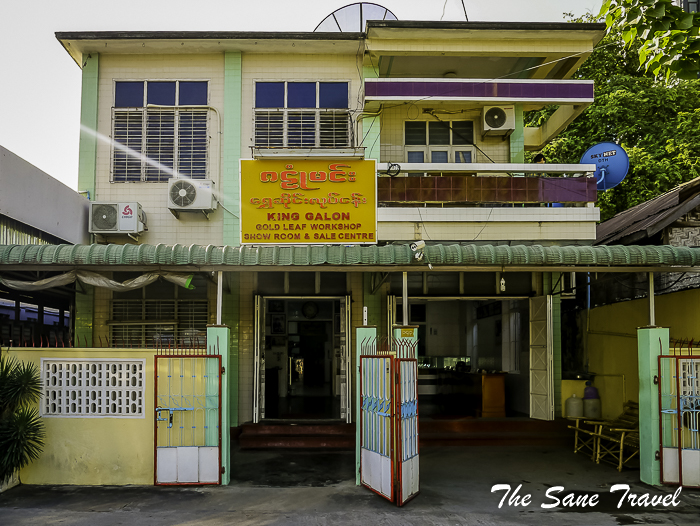
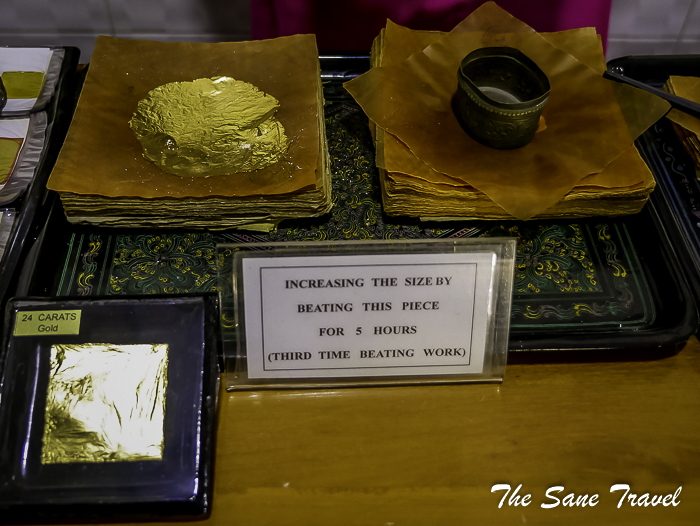 King Galon workshop consists of two main areas: one for men to beat gold, the rest for women to cut and pack gold leaf. In the area for men, the stone pedestals are placed next to a large fifteen pound sledgehammer to beat thin gold leaf. Workers have to sweat to create a thin gold leaf, 0.000005 of an inch thin.
King Galon workshop consists of two main areas: one for men to beat gold, the rest for women to cut and pack gold leaf. In the area for men, the stone pedestals are placed next to a large fifteen pound sledgehammer to beat thin gold leaf. Workers have to sweat to create a thin gold leaf, 0.000005 of an inch thin.
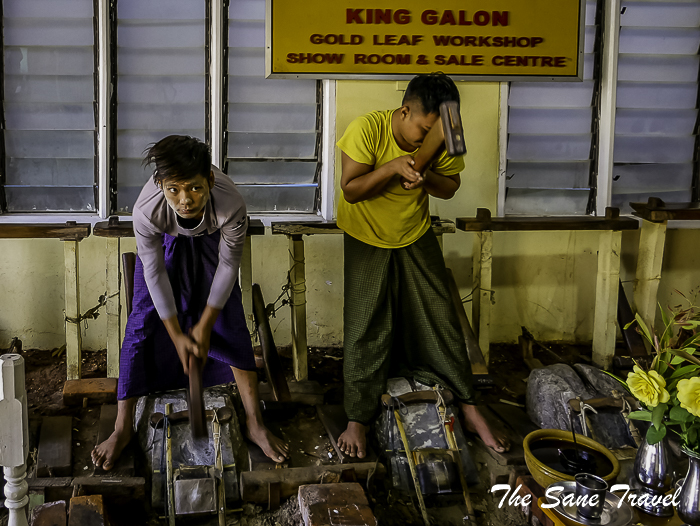 Meanwhile, women employees’ cut golden leaves into squares of 2 inches or smaller to be packed in a piece of paper and small plastic bags, then sold to local residents and tourists.
Meanwhile, women employees’ cut golden leaves into squares of 2 inches or smaller to be packed in a piece of paper and small plastic bags, then sold to local residents and tourists.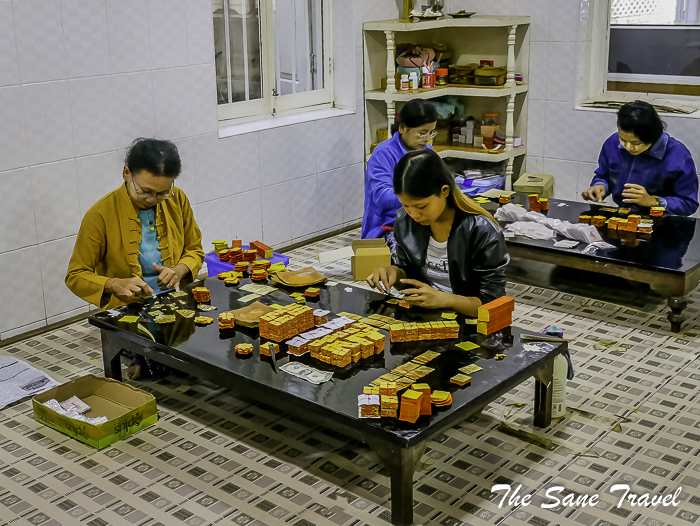 Good explanation in English and an opportunity to buy golden leaf souvenirs and jewelry. No pressure.
Good explanation in English and an opportunity to buy golden leaf souvenirs and jewelry. No pressure.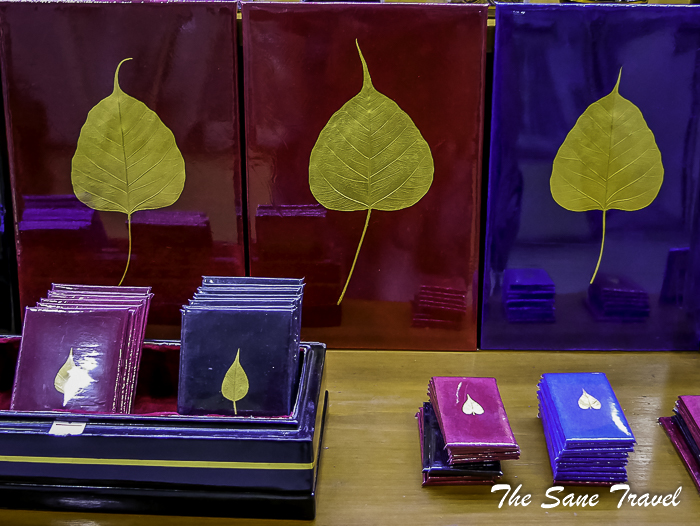 Address: No. 143 36th Street between 77th & 78th Street, Mandalay
Address: No. 143 36th Street between 77th & 78th Street, Mandalay
Admire whitewashed stupas of Sandamuni Pagoda
On your way to Mandalay hill, visit Sandamuni pagoda located near Kuthodaw pagoda. It features the pagoda and hundreds of white stupas with inscribed marble slabs located in a smaller area. Sanda Muni Pagoda complex was built as a memorial to assassinated Crown Prince Kanaung in the 19th century.
![98 sandamuni pagoda mandalay myanmar thesanetravel.com 1630200]()
![100sandamuni pagoda mandalay myanmar thesanetravel.com 1630180]()
![103 sandamuni pagoda mandalay myanmar thesanetravel.com 1630192]()
![104sandamuni pagoda mandalay myanmar thesanetravel.com 1630196]()
![106 sandamuni pagoda mandalay myanmar thesanetravel.com 1630209]() Climb Mandalay Hill for awesome sunset views
Climb Mandalay Hill for awesome sunset views
Almost everyone who visits Mandalay goes to this hill. It is the landmark of Mandalay and also serves as a natural viewpoint because it overlooks the city. Visitors often watch the sunset over the city plains there because of the stunning views. According to a legend, Lord Buddha visited the hill and made a prophecy that a great city would be established at its foot. Your way up will lead you through many pagodas.
Practical information
Take a tuk-tuk to get to the main entrance of the Mandalay hill guarded by chinthe (half lion, half dog) statues guarding the entrance. Be prepared to take off your shoes and make your way through many pagodas and allocate about 40 minutes for a climb. At the top, be prepared to pay a 1000 kyats entrance fee.
Be prepared to take off your shoes and make your way through many pagodas and allocate about 40 minutes for a climb. At the top, be prepared to pay a 1000 kyats entrance fee.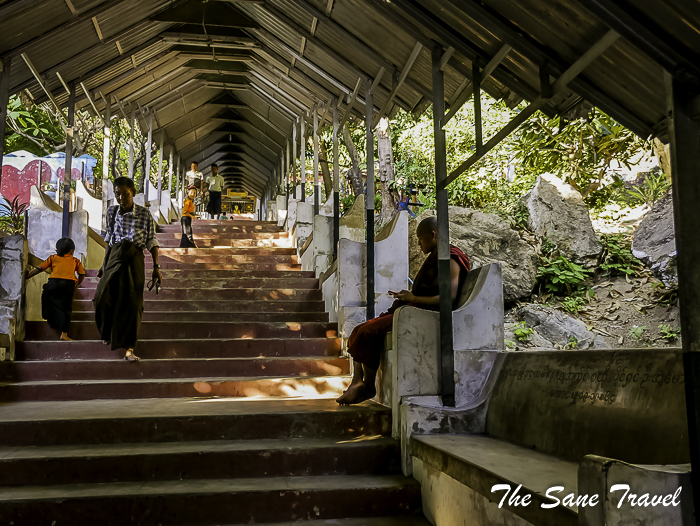
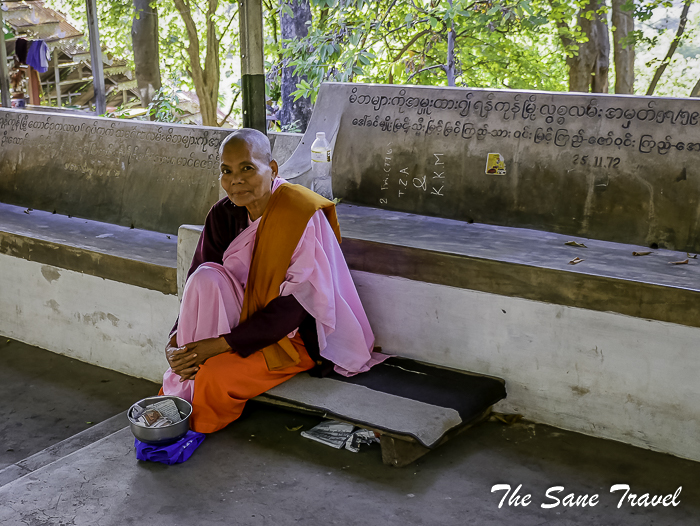
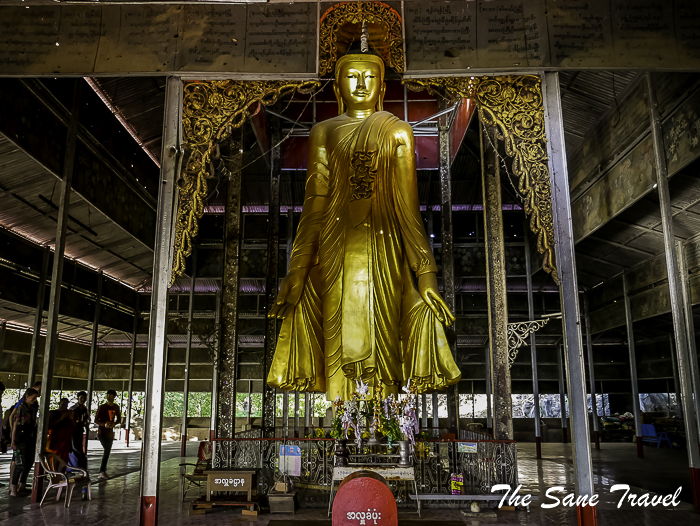

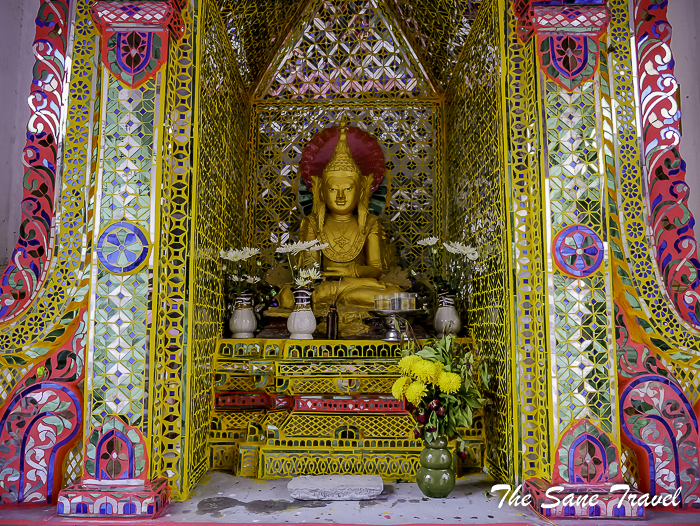

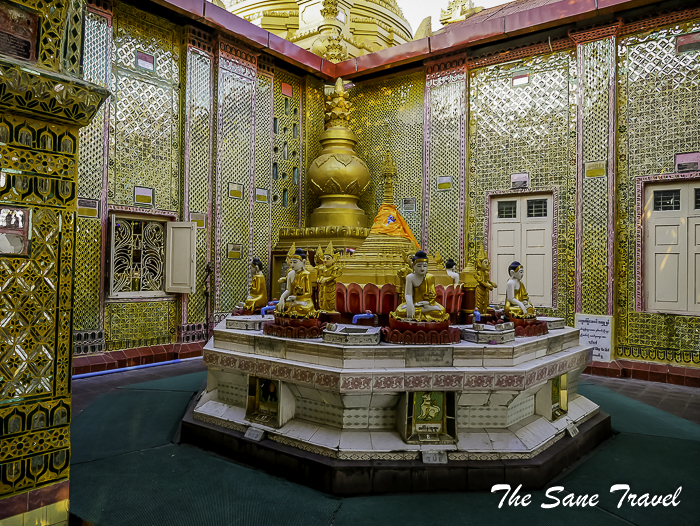


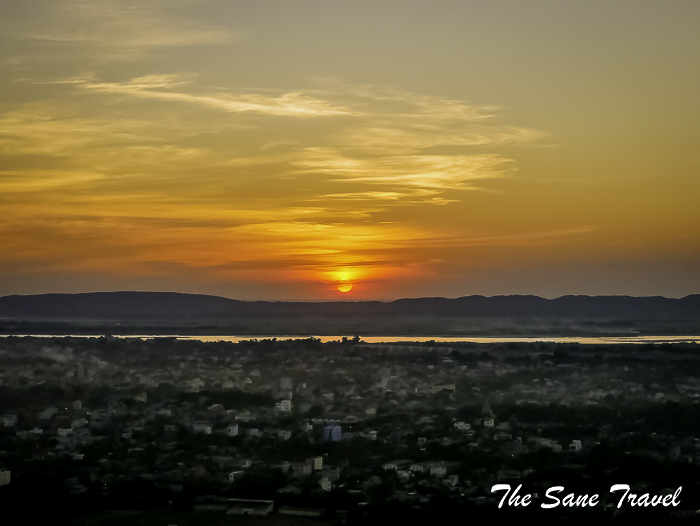
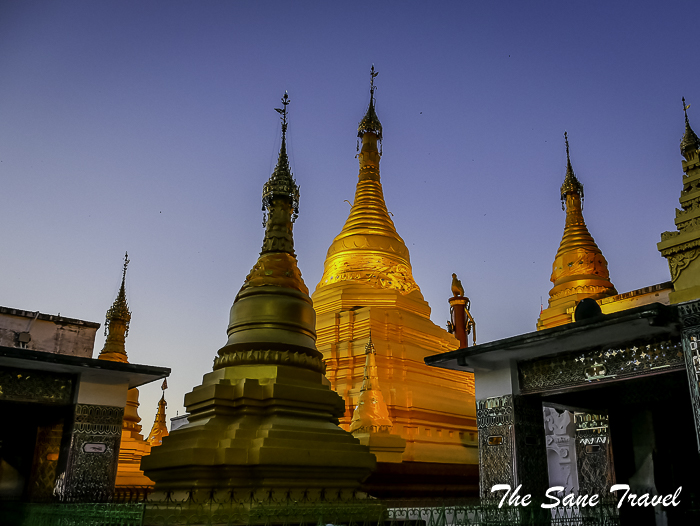
Watch a colorful water fountain show
On your way back to the hotel, stop to admire a water fountain show. The water fountain in Mandalay Moat attracts visitors every night. The Mandalay city institutions installed a circular water fountain for daily water shows. The show includes a seven colour lighting display with different kinds of music at night on the Mandalay Moat between 26 street and 72 street. The water fountain controlled by a central computer is 183 feet long and 100 feet high.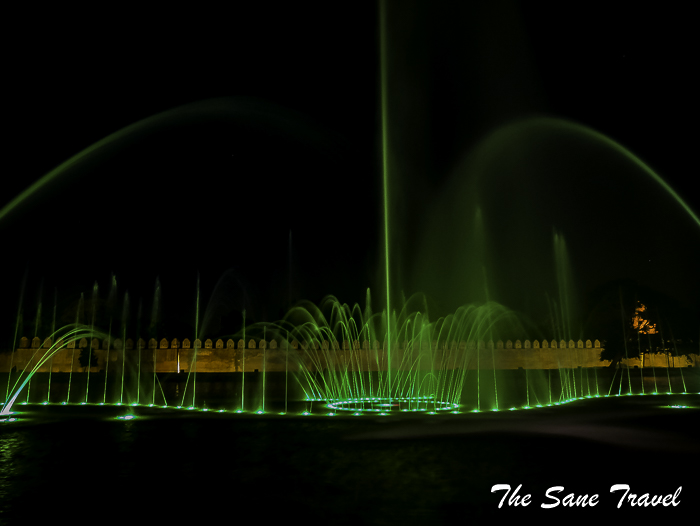
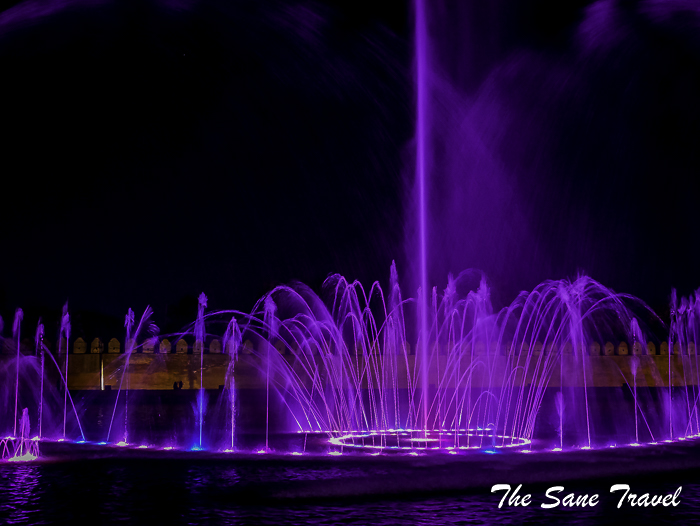 Practical information
Practical information
Mandalay has a "Mandalay Zone Fee" of 10,000 kyat that covers most of the central attractions and lasts for about a week. Buy it from the first attraction you visit. The tickets are not always checked at all attractions and you might be able to get individual cheaper tickets for some attractions. Access to the Mandalay hill requires an additional entry fee of 1,000 kyats, and if you decide to go to Mingung and Sagaing they are 5,000 kyat extra (not always enforced).
Like it? Pin it!
I very much liked the service of the Asian Tour Travel Company which took care of my travels, transfers, and accommodation, so I just had to do my own sightseeing.
Want to see more of Myanmar? Check things to do in Yangon! What did you think? Have you been to Mandalay? Or perhaps you’re thinking of visiting there in the near future? Either way, I’d love to hear from you so please add your comments below.
Author: Anita Sāne

About the author
Anita is a part-time traveller, passionate photographer and a retired career woman from Latvia, travelling mostly solo for more than 15 years. She is a skilled travel planner who plans and executes her travels by herself. Anita wants to show you how to travel the world and open your mind to new experiences. Follow her on Facebook, Instagram, Pinterest, Twitter and Bloglovin.

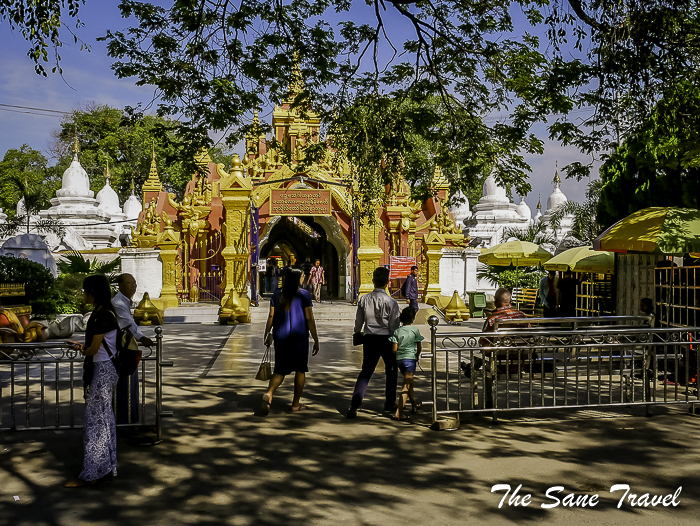

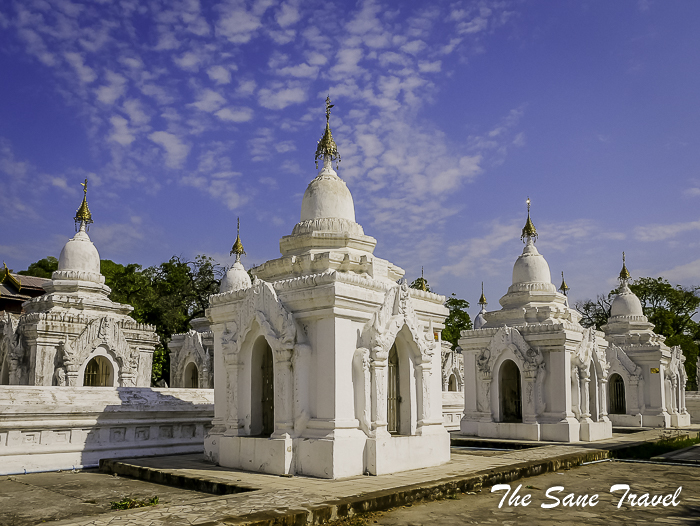
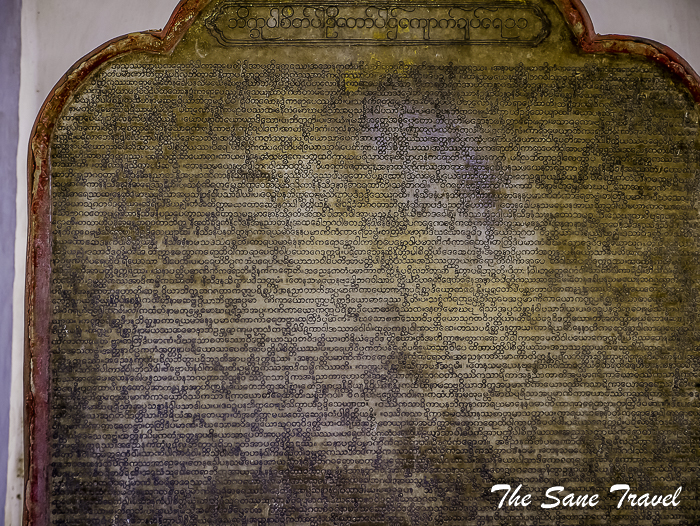
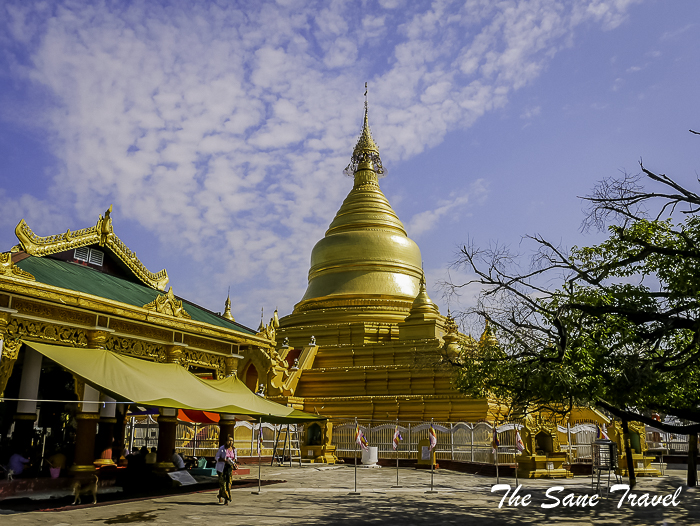
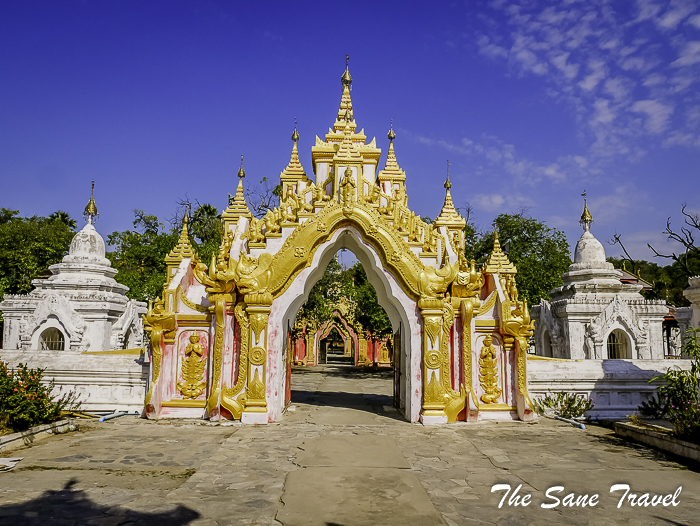
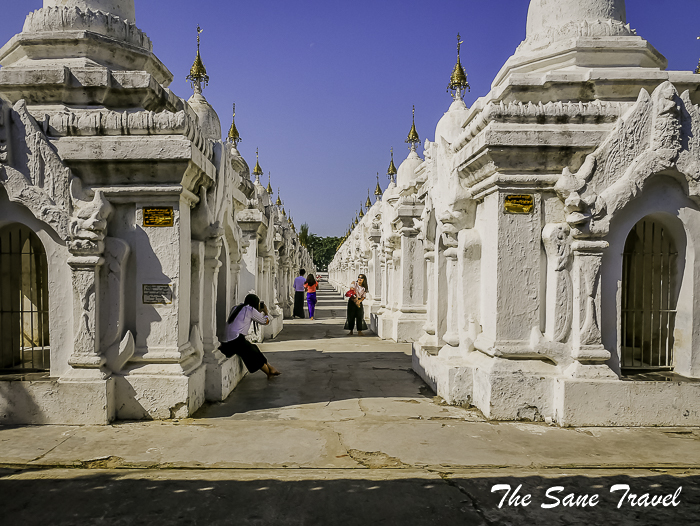 Visit the ancient capital Inwa (Ava)
Visit the ancient capital Inwa (Ava)
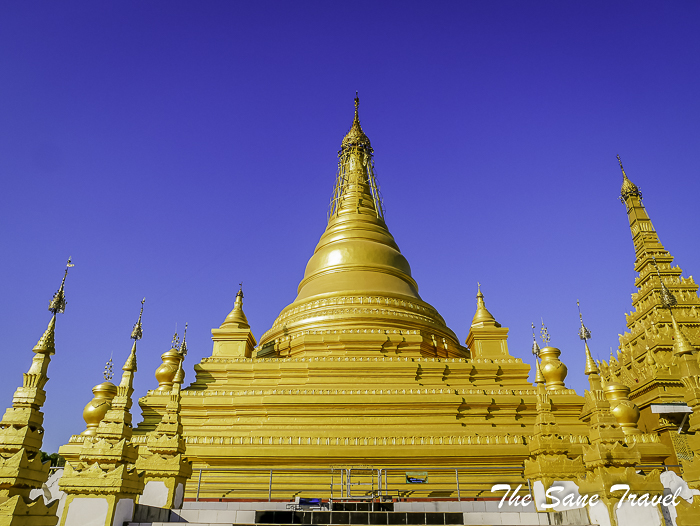
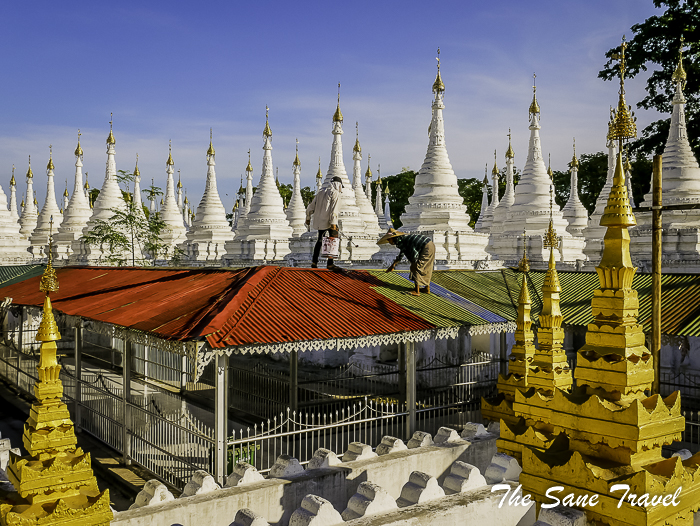
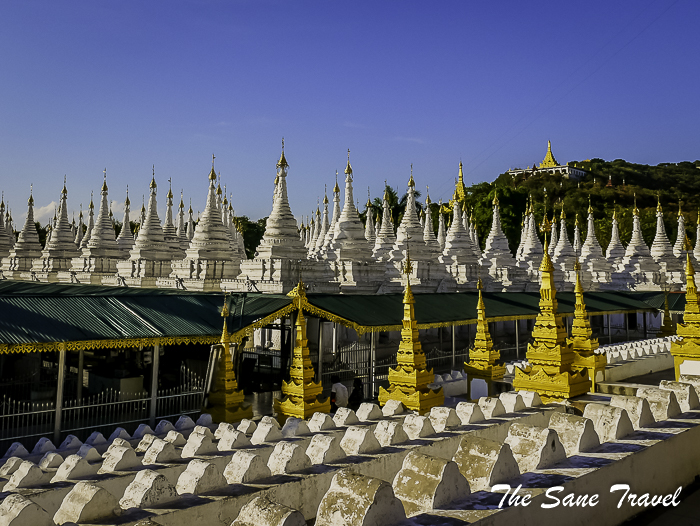
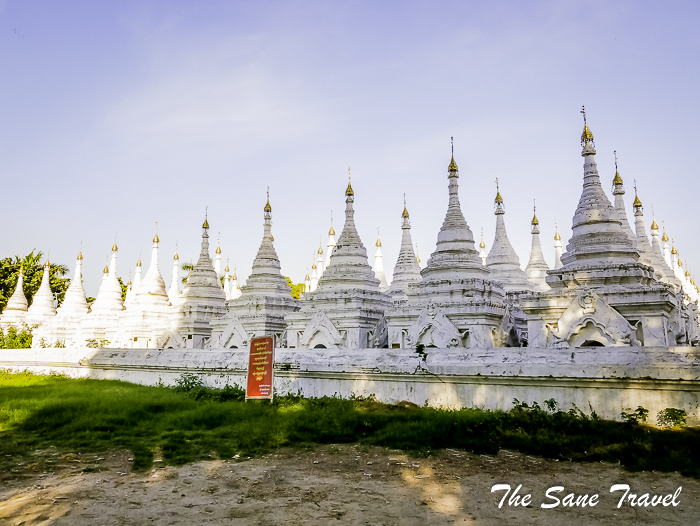 Climb Mandalay Hill for awesome sunset views
Climb Mandalay Hill for awesome sunset views


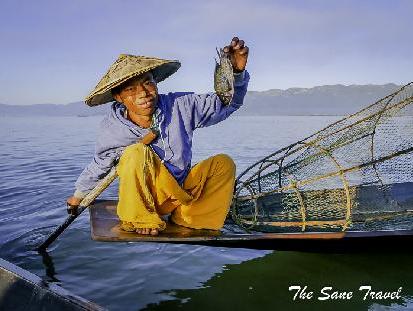


Report
My comments